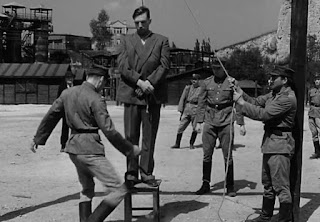John Lee - "The man they could not hang".
One of hangman James Berry’s most famous (non) jobs was the strange case of John Lee at 8.00 a.m. on Monday the 23rd of February 1885 at Exeter prison. All the normal preparations were made on the gallows, set up in the coach house, but when Berry operated the lever, nothing happened.
Berry and the two warders holding Lee, stamped on the trap doors but to no avail, and Lee was then taken back to his cell whilst the release mechanism was tested. It worked perfectly. The process was now repeated but with the same result and yet again the trap worked perfectly after Lee was removed. After the third unsuccessful attempt at 8.10 a.m., the governor stayed the hanging and the Under Sheriff travelled to London where he briefed the Home Office.
As a result Lee was reprieved later that same day by the Home Secretary, Sir William Harcourt and the official document sent by train late that night. The governor immediately conveyed the news to Lee.
After serving a life sentence Lee was released from Portland Prison on the 18th of December 1907 and on the 22nd of January 1909 he married Jessie Augusta Bulled at Newton Abbot.
Various theories abounded as to why the trap would not open with Lee on it, ranging from divine intervention through the wood swelling in the damp weather (given by most newspapers) to the more unbelievable, one of the prisoners who had helped to erect it placing a wedge between the leaves of the trap which he removed again as soon as Lee was taken off and reinserted at each new attempt. The reality was much more prosaic.
When the trap had been erected in the coach house at Exeter, having been previously used at a different location for the hanging of Annie Tooke in 1879, the metal work was not installed correctly and one of the long hinges fouled on the side of the pit when there was weight on the trapdoors but not when there wasn’t.
There were a number of calls for a formal enquiry into the incident but it is not known whether there actually was one, once the real reason for the failure had been discovered.
Twenty year old John Henry George Lee had been convicted of the murder of his employer, 68 year old Emma Anne Whitehead Keyse, for whom he worked as a footman. The crime occurred on the night of the 15th of November 1884. Emma was found battered to death in the dining room by Elizabeth Harris, the cook. The body had been doused in lamp oil and set on fire at her home at “The Glen” in Babbacombe, near Torquay, Devon. Lee was arrested and blood stains were found on his clothes.
He was tried at Exeter before Mr. Justice Manisty commencing on the 3rd of February 1885 and lasting three days.











Comments
Post a Comment